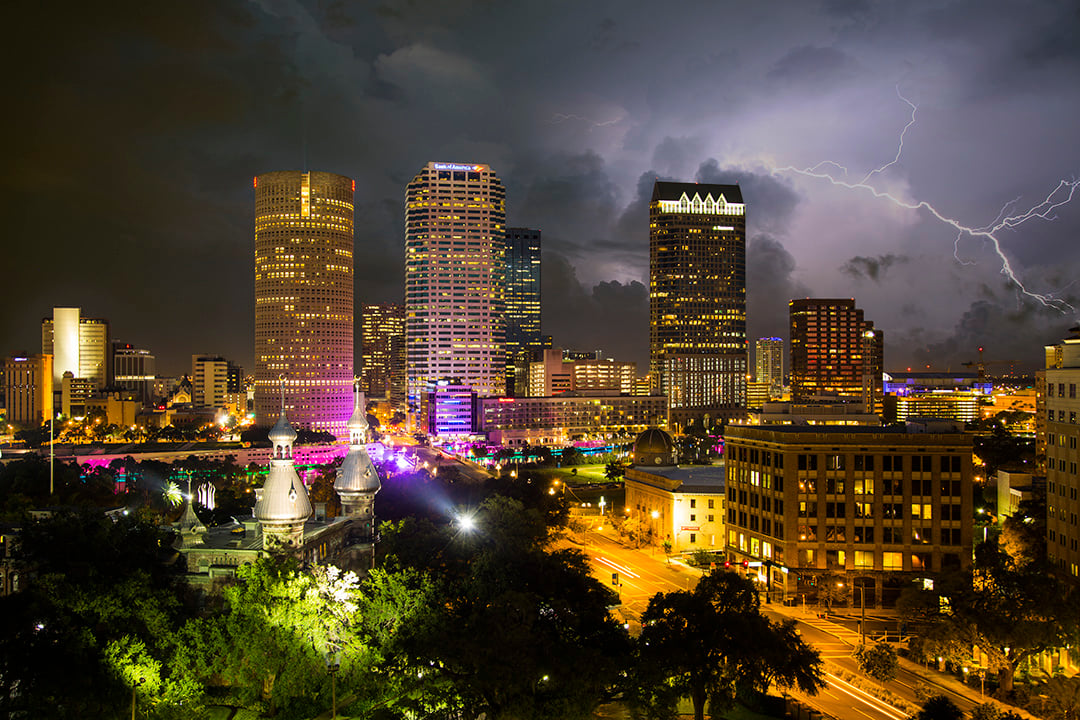
Welcome to the “lightning capital of the U.S.”
If you’ve lived in Florida for any length of time, you’ve probably seen one of our incredible lightning shows. Although it’s an amazing phenomenon, lightning can be deadly! And summertime, when we’re outside having fun, is the peak season for thunderstorms and lightning. Since thunderstorms can pop up at any time, it’s important to have a plan to protect yourself and your loved ones.
If you find yourself stuck in a thunderstorm, follow these tips to stay safe from lightning:
General safety:
- Be aware of the weather forecast for your area and pay attention to advisories and alerts issued by emergency authorities.
- If you hear thunder, the lightning is within ten miles. The shorter the time elapsed between when you see lightning and hear thunder, the closer the lightning.
- Wait at least 30 minutes after a thunderstorm to go outside. Lightning can strike from as far as 10 miles away.
Seek shelter indoors or in low-lying areas:
- Seek shelter in a house, a large building, or an automobile with a metal roof.
- The best shelter is a permanent building; small buildings or sheds are not safe. Vehicles with metal roofs are also safe but don’t touch any metal surfaces and keep all windows closed.
- DO NOT seek shelter underneath canopies, small pavilions, or near trees. Standing under trees accounts for 18% of lightning deaths and 13% of injuries.
- If lightning is near and there isn’t a building nearby, crouch down and put your feet together. Place your hands over your ears to minimize hearing damage from thunder. Avoid being closer than fifteen feet to other people.
Avoid water-related activities:
- If you’re in the water, get out as quickly as possible. Water conducts electricity and increases the risk of being struck by lightning. Boating, fishing, and other water-related activities account for 13% of lightning deaths and 6% of injuries.
- Avoid high ground. Seek shelter in the lowest area and avoid open spaces. Open spaces, fields, and ballparks account for 28% of lightning deaths and 29% of lightning injuries.
Do not touch metal objects:
- Playing golf? Stop. Do not hold a metal golf club during a thunder or lightning storm. Take off your golf shoes with metal spikes and avoid golf carts.
- Do not use any metal objects, including electric wires, fences, machinery, motors, sinks, stoves and power tools. Items like these can conduct electricity if struck by lightning.
- Stay away from utility poles, transformers, substations and power lines. If you see damaged electrical equipment, call 911 and then call Tampa Electric at 877-588-1010.
- Do not ride bicycles, farm equipment or motorcycles.
Stay away from windows and doors:
- If you’re indoors during a thunderstorm, stay away from doors and windows. Do not use a landline telephone and take off headphones (wired or wireless).
- Turn off, unplug, and stay away from appliances, computers, power tools, and TV sets. Lightning can strike exterior electric and phone lines and send shocks to inside equipment.
Provide medical attention:
- If you see someone struck by lightning, call 911 and perform CPR if the person is unresponsive or not breathing. Lightning victims do not carry an electrical charge and are safe to touch. And use an Automatic External Defibrillator (AED) if one is available.
We urge you to stay informed and remain vigilant during thunderstorms. Following these safety tips can reduce your risk of being struck by lightning. For more storm information, visit our Storm Center or call 888-223-0800. You can also learn more about lightning at weather.gov.
